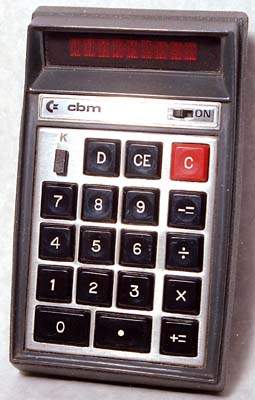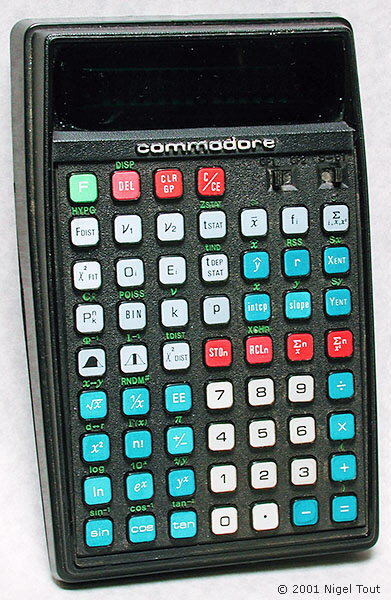

Commodore Hand-held Calculators
1971 - 1978
by Larry Gilbert

Commodore Business Machines (CBM), best known for their innovative and popular personal computers such as the VIC-20, 64, and Amiga, was a pioneering and major force in the pocket calculator industry. No other manufacturer I can think of produced so many calculators of such widely divergent styles from each other.

Commodore (cbm) C110
The first pocket calculator produced under the Commodore name appears to be the C110. This model is identical in every way to the Bowmar 901B and Craig 4501, but is much, much rarer. It is no doubt related to the C108 and C112, popular small desktop units released in 1971 and advertised heavily in big-city newspapers, yet I have not seen the C110 mentioned in any of these ads. A November 1972 issue of Electronics magazine indicates in passing that Bowmar made "special models" for CBM that were like the 901B, but nowhere else have I seen a reference to this Bowmar/Commodore link. The serial number on my C110 is "G8897", which is unusual in that both Bowmar and CBM serial numbers were purely numeric.
The C110 was probably marketed beginning in September/October 1971, but was immediately (January 1972) followed by a uniquely Commodore product, the Minuteman 1. This model retained the "Klixon" keypad of the C110, but used a beautifully sculpted, slightly bowed white case composed of thick, smooth plastic and a reverse-painted name below the display. Curiously, the on/off and floating decimal switches were located below the keypad.
By the end of 1972, Commodore introduced the Minuteman 2, which bore a general similarity to the Minuteman 1, but featured a re-designed keypad with red, white, and (pale) blue keys. (There is a version of the MM2 with the MM1 keypad.) The revised Minuteman 2, in my opinion, is a truly classic design. The metallic keypad area of the MM1 appears somewhat at odds with the elegant look of its case, but the MM2 has an all-plastic faceplate with raised square plastic keys which is in greater harmony with the rest of the unit. A later version of the MM2, the MM2SR, is thinner, with a black case that accentuates the bowing more, and includes a few extra functions. The MM2SR also has small, oval, red/white/blue keys, very different from its predecessors and identical to those found on the next series, the Minuteman 3. The red, white, and blue keys were to become somewhat of a recurring motif among Commodore calculators.
In late 1973, Commodore introduced the Minuteman 3 series. This was a popular model and there are numerous variations of it (at least eight): some use sealed rechargeable batteries (identified by an "R" at the end of the model number, a convention Commodore continued to use in its later calculator lines), others use a 9-volt; one (MM3S) has a square root key; another (MM3P) has a percent key; yet another (MM3M) has a memory function. These all share a small, white, wedge-shaped case, a radical re-design from earlier models. Shortly thereafter, Commodore produced the Minuteman 6, which is even smaller and more angled, but in a gray metal case. A unique feature of the MM6 is its use of Reverse Polish Notation, otherwise unknown among Commodores, and it sports an Enter key. There is an algebraic version of the MM6 too and there is a version with rectangular keys and one with oval keys. Another variation, the MM6X, appears identical to the MM6.
While producing the Minuteman models, Commodore also was selling a parallel series, the US series, which contains some unique designs. Most of these appear to be AC-powered, with two exceptions: US*3 and US*4. Both of these have large tube displays; the US*3 is an unusual pastel green and white two-tone unit. Other than the US*1, which looks like a huge handheld model (but AC only) with large red/white/blue keys, this series appears quite difficult to locate.
At this point (late 1973-early 1974), calculator history reached a turning point. Prices had dropped from $400 in early 1971 to the $50-$100 level, but still were priced a little too high for mass consumption. Then, in September 1973, National Semiconductor introduced the model 600 at $29.95 (and 900 at $39.95) and Litronix introduced the 1100 shortly thereafter at $39.95. The price wars had begun and Commodore jumped into the fray with a series of low-priced, radically re-designed units, which I call the 700/800 series. These were all slender, stylish, lightweight models perhaps patterned after the Sinclair Cambridge, which had just come on the market. (The Sinclair influence may not be too far-fetched, as many of these Commodore products were made in England and used the CBM name). They came in a variety of neutral shades, but mostly tan. Eventually, some of them sold for under $10 and, judging by the ease with which I find them at flea markets, they must have been quite popular. The most advanced model is perhaps the 899, which has niceties like square and pi.
Through the 700/800 series, Commodore continued to use red LED displays, but by 1975 fluorescent displays were becoming increasingly popular due to their lower cost. Commodore assimilated this trend, too, by creating an entire series based on it: the Green Line (GL) series. These popular models also looked like nothing Commodore had produced before: thicker than the 700/800 units, with an interesting profile vaguely similar to the Hewlett-Packard "Woodstock" or "20" series. A rarer variation of the GL line is the "9" series, such as the 9R31 or 9D31 (a "D" in Commodore vocabulary means "disposable batteries"); this series may have been produced for the European market. Unfortunately for collectors seeking mint examples, the GL calculators used a lot of painted-on silver trim which is almost always worn off to some extent.
Commodore stayed out of the market for sophisticated scientific and financial models while HP and TI battled for control of that niche. But as 1974 progressed, and profits from four-function machines plummeted, other companies, such as Litronix (2200 series), Casio (FX-10), Sperry Remington (SSR-8), Bowmar (MX-100), and Canon (F-5), entered into the arena. In characteristic fashion, when Commodore did decide to produce super-calculators, they did so aggressively, eventually taking the genre to its extreme.
Their first scientific model, appearing in late 1974, seems to be the SR-1400, which introduced nomenclature that Commodore used for most of these models: "SR" prefix indicates a scientific model, "F" indicates a financial. This calculator, which came in two faceplate variations (black plastic or the rarer silver metal) devotes one key to a function, so we are faced with nearly 40 keys. This abundance of keys and functions became a trademark of Commodore's advanced models. Mention should be made at this point of one of Commodore's more unusual models: SR7919. This scientific calculator is housed in a 700/800 case, yet has a model number from a later period. Also unusual are the dual-function keys with both functions printed on the key itself, one on a shiny gray background, the other on blue, giving the unit a singular appearance. An anomaly, it's unknown to me whether it pre- or post-dates the SR-1400.
Some of the more interesting scientific models include the SR-1800, which has a fluorescent display and a stylized wedge-shaped case; the SR4148R, a well-constructed, heavy-duty model with 48 keys; and the SR5190R and its cousins (4190, 9190, and perhaps others), which have close to 50 keys, most with two functions, including some rather specialized ones such as metric conversions and unusual distributions (the Poisson and Gaussian, for example). These last models have approximately 90 functions, perhaps accounting for the model number.
The earliest financial model appears to be the F4146R (with 46 keys). Interestingly, the owner's manual features a picture of a minuteman on the cover (perhaps someone could explain the rationale behind the minuteman nomenclature as it relates to calculators [Probably an allusion to the 'Minutemen' civilian militia of the American Revolutionary War who were known for being ready for action within a minute's notice. These calculators were similarly instantly ready for action, and also often used a patriotic red, white and blue color scheme.]). In 1977, Commodore came out with their ultimate specialized calculators: M55, N60, S61 (known as the "Series 60" line). As the model numbers indicate, these have 55, 60, and 61 keys, respectively, most with two functions. The M55 was designed for mathematicians, and contains arcane operations such as Bessel functions and Legendre polynomials; the S61 is a powerful pocket statistical calculator, capable of computing values for nine different statistical distributions; and the N60 had flight navigation functions. They appear to be descendants of the SR5190 group, which provided some of these specialized functions.

Commodore S61, Statistical calculator.
Commodore also produced at least a couple of programmable units around 1977: P50 and PR100. Programs could not be stored on external media, however, and neither model appears to have continuous memory, so the program was lost when the unit was turned off. These 1977 models are by and large manufactured in Hong Kong, use replaceable batteries, and have fluorescent displays. They tend to be constructed of a more roughly textured plastic and are much lighter in weight than earlier models. They also have silver trim which rubs off with time.
Many Commodore calculators have a somewhat busy look, with lots of keys and contrasting color combinations. One exception is the 301, a four-function unit which comes in a thin metal case and is oriented horizontally. It has a red display and probably hails from about 1975 or 76, when other similar models appeared (the National Semiconductor Attache and Executive come to mind). The sleek metal case was perhaps seen to have a more "professional" look to it.
In mid-1977, Commodore introduced the PET personal computer and at that point backed away from calculators. They did make at least two very thin LCD models around 1978; these have the amber LCD that was common in the late '70s. An unusual feature of the LC81 is its use of a single AA battery in an enlarged portion of the case instead of the button-style batteries usually found in these types of calculators.
This quick review of Commodore pocket calculators covered a lot of ground and surely there is more to be unearthed. Commodore had a strong European division which marketed many models that were not sold in the U.S. Many of these are recognizable by the use of the CBM name and logo. They also produced models sporadically for many other companies, most notably JC Penney.
Copyright 1997, Larry Gilbert.
As additional information to Larry Gilbert's article, this Commodore guide to 'Choosing your calculator' dates from the late 1970s, since it has a changes sheet inserted which is dated April 1980. The price list included was for the UK market so prices are in £ (GBP) and to approximately convert these to contemporary US$ multiply by 2.2.
Calculator Articles
Vintage Calculators
Text & photographs copyright, except where stated otherwise, © Nigel Tout 2000-2026.
